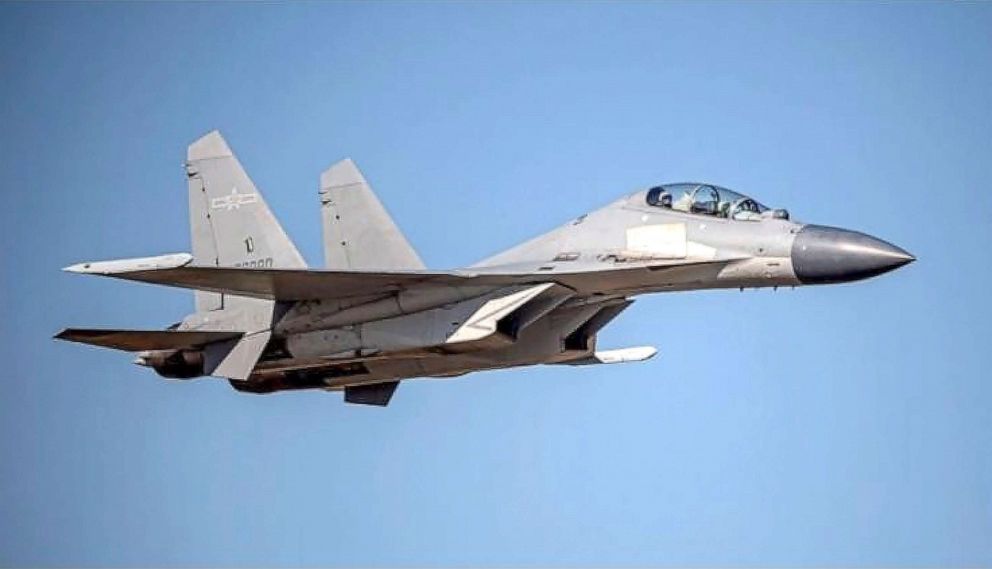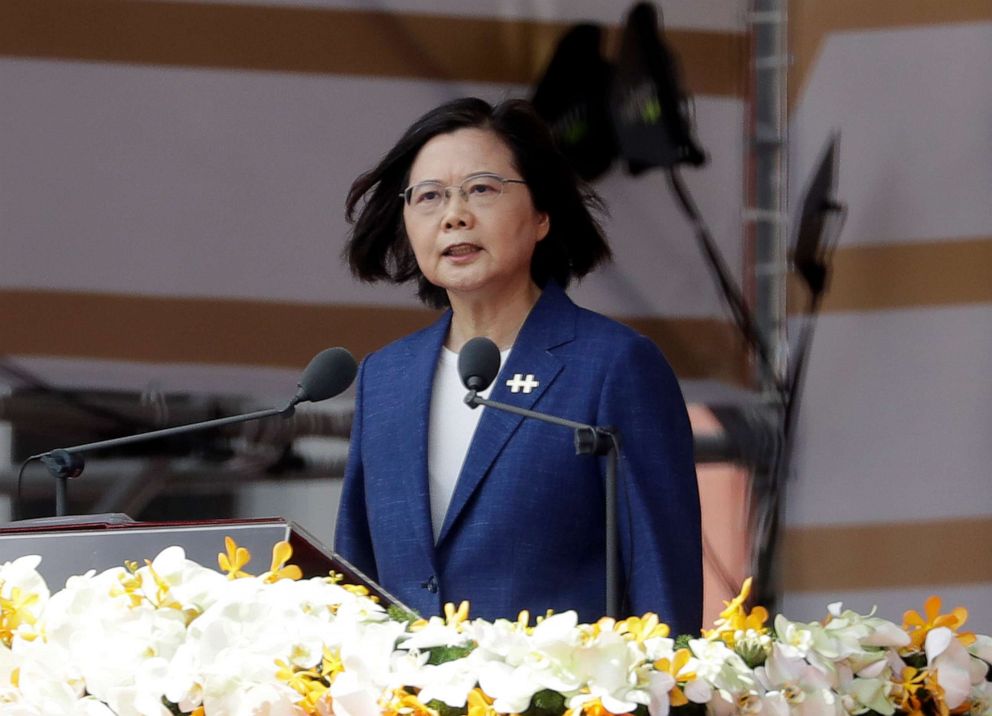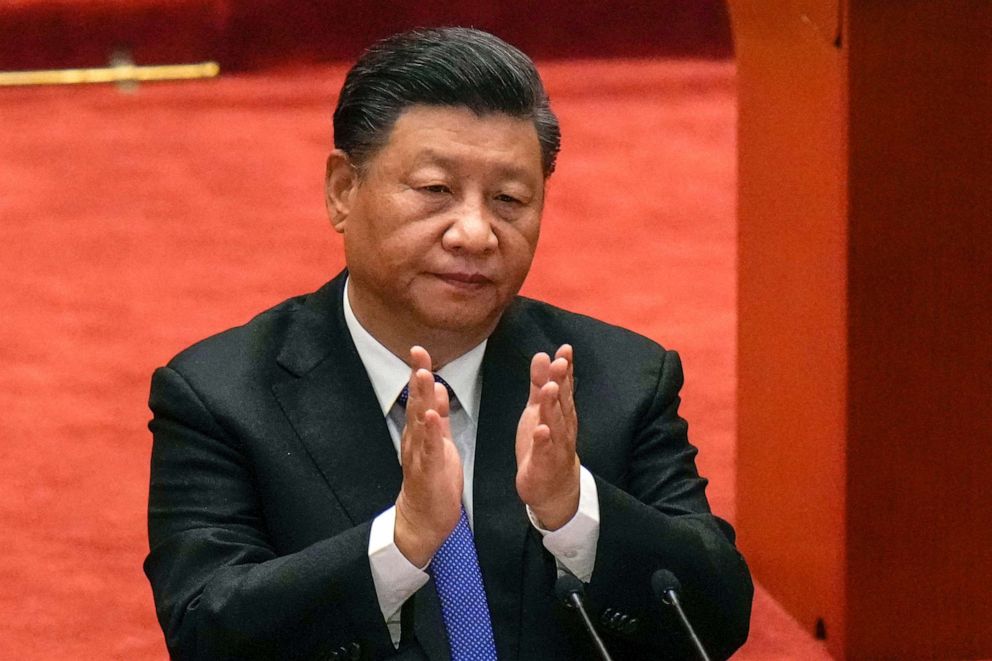What to know about the escalating tensions between China and Taiwan
There has been increasing "gray-zone" conflict across the strait.
Since the beginning of October, Beijing has sent more than 150 military aircraft into Taiwan’s air defense zone in an attempt to intimidate the Taiwanese government. In recent days, the People’s Liberation Army also mounted large amphibious landing drills on the mainland side of the Taiwan Straits -- an unambiguous show of force and a sign of escalating tensions in the region.
Taiwan’s Defense Minister Chiu Kuo-cheng even warned the Taiwanese legislature earlier this month that Beijing might be able to launch a "full-scale" invasion of the island by 2025.
Tensions across the Taiwan Straits are now at the highest level in years and unforeseen error from either sides risks dragging the United States into a potential conflict with China.
The spokesman for Beijing’s Taiwan Affairs Office, Ma Xiaoguang, called the military exercises a "just" move aimed at "separatist activities" on the island and what it says is “collusion with foreign forces” by the ruling Democratic Progressive Party (DPP) -- a not-so-veiled allusion to U.S. support for Taiwan.
At the heart of the matter is Beijing's view that Taiwan is a breakaway province of 23 million people that will eventually have to "reunified" with the rest of China. Beijing leaders continue to press for what they call "peaceful reunification" but have not ruled out the use of military force. Xi Jinping has ramped up the pressure on Taiwan, making reunification a stated goal of the “China Dream” of “national rejuvenation.”
Since coming back into power in 2016, the DPP government has increasingly leaned into the island’s separate self-rule status, and has just fallen short of declaring independence, which Beijing views as a bright red line.

The ‘Taiwan Question’
Beijing sees the Taiwan Question as a relic of national shame that originated when the island was taken from the imperial Qing Dynasty by Japan as a colony in 1895.
At the end of the Chinese Civil War in 1949, the defeated Kuomintang (KMT) Government of the Republic of China (ROC) retreated to Taiwan, which they reclaimed at the end of WWII. Meanwhile the prevailing Communist Party of China declared the mainland the People’s Republic of China (PRC), with both sides eyeing the eventually "reunification" of China. The ROC and the PRC both continue to claim legitimate sovereignty over China with Beijing frequently threatening to liberate the island.
The United States maintained official diplomatic relations with Taipei until 1979 when it switched its recognition to Beijing. The switch was made easier at the time when Taiwan wasn’t the democracy it is today but an authoritarian regime.
In switching diplomatic recognition to Beijing, the U.S. and China agreed to abide by the "One China" Policy. For the U.S. it was an acknowledgement that the “Chinese on either sides of Taiwan Straits maintain there is but one China” but the status of Taiwan is undetermined and is expected to be resolved peacefully. For Beijing it means that Taiwan belongs to Beijing’s "One China." This different interpretations of the policy have been at the foundation of the U.S.-China relationship.
In order to give assurances to Taiwan, the U.S. Congress passed the Taiwan Relations Act, which calls for the U.S. to maintain unofficial, de facto relations with Taipei and allows the U.S. to provide Taiwan arms for self-defense. The act did not guarantee, however, that the U.S. would intervene if Beijing attacks or invades the island but sets up a "strategic ambiguity" in hopes of dissuading Beijing from attacking and Taipei from unilaterally declaring independence.
Beijing soon began offering Taipei the option of a “peaceful reunification.” As Hong Kong prepared to be handed back over from the British to the Chinese in 1997, Beijing proposed using the "One Country, Two Systems" principle devised for Hong Kong as model to bring Taiwan back into the fold.

Isolating the Tsai Ing-wen government
Since coming into to power in 2016, Tsai has tiptoed the acceptable bounds of the cross-strait relationship but has never publicly embraced independence nor the 1992 Consensus, the latter angering Beijing.
Almost immediately Beijing cut off all official lines of communication with Tsai’s DPP government, painting the DPP as secessionists. Beijing suspended all Chinese tour groups to the island cutting, off a reliable source of revenue on the island. Beijing then began poaching Taiwan’s remaining diplomatic allies in hopes of completely isolating the government. During Tsai’s first term as president she lost seven diplomatic allies to Beijing.
The squeeze almost worked. A year out from the 2020 election, Tsai was on shaky ground for re-election but then 2019 Hong Kong protests erupted. Playing into the fear of increased Beijing encroachment and the broken promises of “Once Country, Two Systems “ gave Tsai the momentum to be reelected in a landslide in early 2020 just before the COVID-19 pandemic.
The prospect of “One Country, Two Systems” had become so toxic in Taiwan after the Hong Kong protests that both the KMT and the DPP publicly rejected it as a possibility for Taiwan.
'Gray-zone' warfare amid cratering US-China ties
Emerging from the pandemic with a renewed confidence, Beijing began to refocus its pressure campaign on Taiwan just as its relationship with Washington began to crater.
Beijing soon began to employ what Taiwan called low-level “gray-zone warfare” to exhaust the Taiwanese military and people. In 2020, Chinese warplanes made 380 incursions into Taiwan’s air defense zone making Taipei scramble their own jets to respond every single time. The incursions only increased this year.
In response, the U.S. has engaged with Taiwan more openly. Former Secretary of State Mike Pompeo removed all restrictions between diplomatic contacts between U.S. and Taiwan officials in the finals days of the Trump Administration, infuriating Beijing. The Biden Administration has taken it further by encouraging working ties with Taiwanese officials, even invited the Taiwanese envoy to President Biden's inauguration.
At the same time, Beijing has been nurturing a rise in nationalistic sentiment across the country, fueled in part by their success in suppressing COVID-19 and the growing view that Western powers especially the U.S. is in a state of decline exemplified by its failure to control the pandemic.
The view was further exasperated by Chinese state media playing up the U.S.’s chaotic withdrawal from Afghanistan this summer. China’s nationalistic tabloid Global Times painted the U.S as unreliable, asking whether Afghanistan was “some kind of omen for Taiwan’s future fate?”
Just as Americans have an increasing unfavorable view of China, the Chinese public has had an increasingly antagonistic view of Americans. The Eurasia Group Foundation found that less than 35% of Chinese people have a positive opinion about the U.S. compared to 57% just two years earlier.
Chinese propaganda and pop culture have been cashing in and normalizing a U.S.-China conflict. The Chinese blockbuster "The Battle at Lake Changjin," financed by the government’s propaganda department tells of a PLA victory over U.S. troops during the Korean War. Since Oct. 1st it has grossed over $633 million at the Chinese box office.
Now armed with the most well-equipped military China has ever possessed including the world’s largest navy by number of ships, Xi has been preparing Chinese officials and the military for challenging days ahead.
“We must persist in strengthening the overall planning of war and make preparations for military struggle,” he told the Politburo over the summer and in September told young Communist Party officials, “the great rejuvenation of the Chinese nation has entered a key phase, and risks and challenges we face are conspicuously increasing. It’s unrealistic to always expect easy days and not want to struggle.”

What’s next?
With China facing an unprecedented domestic power crunch, a major real estate developer threatening the economy with an impending default, a major Communist Party leadership meeting in November and the task of holding the Winter Olympics in a few months’ time, Beijing may have some more pressing issues than entering a conflict over Taiwan.
After the unprecedented defense zone jet intrusions, it appears that both Beijing and Taipei have attempted to temporarily dial the temperature down a notch in separate speeches celebrating a shared anniversary across the Taiwan Strait last weekend.
While Xi reiterate his desire for "reunification" he stressed that “peaceful means best serves the interests of the Chinese nation as a whole, including compatriots in Taiwan.”
Taiwan’s Tsai called for dialogue with Beijing on "the basis of parity."
This comes as Beijing and Washington have attempted to stabilize their relationship in recent weeks with a series of meetings.
Even after reports of a small presence of U.S. Marines deployed to train Taiwanese forces on the island -- an act which Beijing could see as a violation of their red line -- the Foreign Ministry spokesperson chose to highlight the incremental process made during a meeting between Biden’s National Security Advisor Jake Sullivan and China’s top diplomat Yang Jiechi which is paving the way for Biden-Xi virtual summit before the end of the year.
When asked about the rising tensions between Beijing and Taipei, President Biden told the press that he raised the issue with Xi on a call.
"I've spoken with Xi about Taiwan. We agree ... we'll abide by the Taiwan agreement," he said. "We made it clear that I don't think he should be doing anything other than abiding by the agreement."
After the comments the Taiwan Foreign Ministry was assured by the U.S. that the American commitment to Taiwan was "rock solid."
Beijing has continued to warn the U.S. against playing the "Taiwan Card."
How U.S.-China relations continue to play out in the coming months and years will ultimately determine Taiwan’s future.




